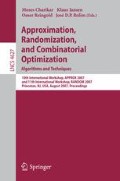Abstract
We consider the following channel assignment problem arising in wireless networks. We are given a graph G = (V, E), and the number of wireless cards C v for all v, which limit the number of colors that edges incident to v can use. We also have the total number of channels C G available in the network. For a pair of edges incident to a vertex, they are said to be conflicting if the colors assigned to them are the same. Our goal is to color edges (assign channels) so that the number of conflicts is minimized. We first consider the homogeneous network where C v = k and C G ≥ C v for all nodes v. The problem is NP-hard by a reduction from Edge coloring and we present two combinatorial algorithms for this case. The first algorithm is a distributed greedy method, which gives a solution with at most \((1 - \frac{1}{k})|E|\) more conflicts than the optimal solution. We also present an algorithm yielding at most |V| more conflicts than the optimal solution. The algorithm generalizes Vizing’s algorithm in the sense that it gives the same result as Vizing’s algorithm when k = Δ + 1. Moreover, we show that this approximation result is best possible unless P = NP. For the case where C v = 1 or k, we show that the problem is NP-hard even when C v = 1 or 2, and C G = 2, and present two algorithms. The first algorithm is completely combinatorial and produces a solution with at most \((2-\frac{1}{k}) OPT + (1 - \frac{1}{k}) |E|\) conflicts. We also develop an SDP-based algorithm, producing a solution with at most 1.122 OPT + 0.122 |E| conflicts for k = 2, and \((2-\Theta(\frac{\ln k}{k})) OPT + (1 - \Theta(\frac{\ln k}{k}))|E|\) conflicts in general.
Access this chapter
Tax calculation will be finalised at checkout
Purchases are for personal use only
Preview
Unable to display preview. Download preview PDF.
References
Raniwala, A., Chiueh, T.: Architecture and algorithms for an IEEE 802.11-based multi-ch annel wireless mesh network. In: Proceedings of Infocom (March 2005)
Kyasanur, P., Vaidya, N.H.: Routing and interface assignment in multi-channel multi-interfa ce wireless networks. In: Proceedings of WCNC (March 2005)
Alicherry, M., Bhatia, R., Li, L.E.: Joint channel assignment and routing for throughput optimization in mu lti-radio wireless mesh networks. In: Proceedings of ACM MobiCom, ACM Press, New York (2005)
Shin, M., Lee, S., Kim, Y.A.: Distributed channel assignment for multi-radio wireless networks. In: MASS. The Third IEEE International Conference on Mobile Ad-hoc and Sensor Systems, IEEE Computer Society Press, Los Alamitos (2006)
Kann, V., Khanna, S., Lagergren, J., Panconesi, A.: On the hardness of max k-cut and its dual. In: Proc. 5th Israel Symposium on Theory and Computing Systems (ISTCS), pp. 61–67 (1996)
Frieze, A., Jerrum, M.: Improved approximation algorithms for MAX k-CUT and MAX BISECTION. In: Balas, E., Clausen, J. (eds.) Integer Programming and Combinatorial Optimization. LNCS, vol. 920, pp. 1–13. Springer, Heidelberg (1995)
Fitzpatrick, S., Meertens, L.: An experimental assessment of a stochastic, anytime, decentralized, soft colourer for sparse graphs. In: Steinhöfel, K. (ed.) SAGA 2001. LNCS, vol. 2264, Springer, Heidelberg (2001)
Damaschke, P.: Distributed soft path coloring. In: Alt, H., Habib, M. (eds.) STACS 2003. LNCS, vol. 2607, pp. 523–534. Springer, Heidelberg (2003)
Holyer, I.: The np-completeness of edge-coloring. SIAM J. Computing 10(4), 718–720 (1981)
Vizing, V.G.: On an estimate of the chromatic class of a p-graph (russian). Diskret. Analiz. 3, 25–30 (1964)
Nishizeki, T., Kashiwagi, K.: On the 1.1 edge-coloring of multigraphs. SIAM J. Disc. Math. 3(3), 391–410 (1990)
Caprara, A., Rizzi, R.: Improving a family of approximation algorithms to edge color multigraphs. Information Processing Letters 68(1), 11–15 (1998)
Kari, C., Kim, Y.A., Lee, S., Russell, A., Shin, M.: Soft edge coloring (2007), Full version available at http://www.engr.uconn.edu/~ykim/soft.pdf
Karger, D., Motwani, R., Sudan, M.: Approximate graph coloring by semidefinite programming. In: Proc. 35th IEEE Symposium on Foundations of Computer Science, pp. 2–13. IEEE Computer Society Press, Los Alamitos (1994)
Alizadeh, F.: Interior point methods in semidefinite programming with applications to combinatorial optimization. SIAM Journal on Optimization 5(1), 13–51 (1995)
Grotschel, M., Lovasz, L., Schrijver, A.: The ellipsoid method and its consequences in combinatorial optimization. Combinatorica 1, 169–197 (1981)
Grotschel, M., Lovasz, L., Schrijver, A.: Geometric algorithms and combinatorial optimization. Springer, Heidelberg (1987)
Nesterov, V., Nemirovskii, A.: Self-concordant functions and polynomial time methods in convex programming. Central Economical and Mathematical Institute, U.S.S.R. Academy of Science, Moscow (1990)
Nesterov, V., Nemirovskii, A.: Interior-point polynomial algorithms in convex programming. SIAM (1994)
Golub, G.H., Loan, C.F.V.: Matrix Computations. The Johns Hopkins University Press, Baltimore (1983)
Goemans, M.X., Williamson, D.P.: Improved approximation algorithms for maximum cut and satisfiability problems using semidefinite programming. Journal of the ACM 42, 1115–1145 (1995)
Galambos, J.: The asymptotic theory of extreme order statistics. Wiley, New York (1978)
Author information
Authors and Affiliations
Editor information
Editors and Affiliations
Rights and permissions
Copyright information
© 2007 Springer-Verlag Berlin Heidelberg
About this paper
Cite this paper
Kari, C., Kim, YA., Lee, S., Russell, A., Shin, M. (2007). Soft Edge Coloring . In: Charikar, M., Jansen, K., Reingold, O., Rolim, J.D.P. (eds) Approximation, Randomization, and Combinatorial Optimization. Algorithms and Techniques. APPROX RANDOM 2007 2007. Lecture Notes in Computer Science, vol 4627. Springer, Berlin, Heidelberg. https://doi.org/10.1007/978-3-540-74208-1_14
Download citation
DOI: https://doi.org/10.1007/978-3-540-74208-1_14
Publisher Name: Springer, Berlin, Heidelberg
Print ISBN: 978-3-540-74207-4
Online ISBN: 978-3-540-74208-1
eBook Packages: Computer ScienceComputer Science (R0)

